A marketing persona is a detailed representation of a target customer based on data and research. It includes demographic information such as age, gender, location, and income level, alongside psychographic details like interests, values, and buying behavior. Companies use these personas to tailor marketing strategies that resonate with specific audience segments and improve engagement rates. An example of a marketing persona is "Tech-Savvy Tina," a 28-year-old urban professional who frequently shops online and values innovative technology products. Data collected from surveys, purchase history, and social media analysis informs her profile, revealing preferences for high-quality gadgets and quick delivery. Brands use this persona to develop targeted digital campaigns that emphasize innovation and convenience, increasing conversion rates.
Table of Comparison
| Persona Name | Demographics | Goals | Challenges | Preferred Channels | Buying Behavior |
|---|---|---|---|---|---|
| Tech-Savvy Millennial | Age: 25-35, Urban, College Grad | Stay updated with latest tech, convenience | Information overload, trust issues | Social Media, Blogs, Podcasts | Researches online, reads reviews, compares prices |
| Budget-Conscious Parent | Age: 35-45, Suburban, Married with Kids | Save money, quality products for family | Limited time, price sensitivity | Email, Facebook, Coupons | Looks for deals, values recommendations |
| Eco-Friendly Enthusiast | Age: 28-40, Urban, Environmentally conscious | Buy sustainable products, reduce carbon footprint | Limited product options, greenwashing concerns | Instagram, Eco Blogs, Community Events | Prefers brands with clear sustainability policies |
| Professional Busy Executive | Age: 40-55, Urban, High Income | Efficiency, convenience, premium service | Time constraints, high expectations | LinkedIn, Email, Industry Events | Prefers premium brands, quick decision making |
Introduction to Persona Development in Marketing Research
A typical marketing persona might be "Urban Millennial Emma," a 28-year-old digital native living in a metropolitan area, who values sustainability and prefers online shopping via mobile apps. Detailed data on Emma's demographics, preferences, pain points, and behavior patterns help marketers create targeted campaigns that resonate with similar audience segments. Developing such personas based on qualitative and quantitative research enhances customer insights and improves marketing strategy effectiveness.
Importance of Personas in Customer-Centric Strategies
Personas, such as "Marketing Mary," a 35-year-old digital marketing manager seeking data-driven tools, play a crucial role in shaping customer-centric strategies by enabling personalized messaging and targeted campaigns. Understanding specific characteristics like demographics, behaviors, goals, and pain points helps marketers design tailored experiences that increase engagement and conversion rates. Integrating well-researched personas into marketing plans enhances customer insights, driving product development and communication that align closely with audience needs.
Key Components of an Effective Persona Profile
Effective persona profiles in marketing research include detailed demographics such as age, gender, income, and education, combined with psychographic data like motivations, challenges, and purchasing behavior. Clear articulation of goals and pain points helps tailor marketing strategies to address specific customer needs. Incorporating real user data and behavioral patterns enhances the persona's accuracy, driving targeted and personalized campaign development.
Steps to Creating Accurate Personas for Marketing
Identify key demographic data such as age, gender, income, and education to build a foundational understanding of your target audience. Conduct qualitative research through interviews and surveys to uncover motivations, challenges, and preferences that influence purchasing decisions. Synthesize this information to create detailed personas representing distinct customer segments, ensuring marketing strategies are tailored effectively to drive engagement and conversion.
B2C Persona Example: The Millennial Online Shopper
The Millennial online shopper persona typically includes individuals aged 25-40 who prioritize convenience, value user reviews, and frequently engage with social media platforms for product discovery. They favor mobile-friendly websites and expect personalized marketing offers based on their browsing history and preferences. Brands targeting this persona should emphasize seamless digital experiences, eco-friendly products, and loyalty rewards to drive engagement and repeat purchases.
B2B Persona Example: The Corporate Decision Maker
The Corporate Decision Maker persona typically represents senior executives such as CEOs, CFOs, or procurement managers who influence purchasing decisions in B2B companies. This persona values detailed ROI analysis, risk mitigation strategies, and scalable solutions that align with long-term business goals. Understanding their priorities enables tailored marketing messages that emphasize cost-efficiency, strategic impact, and operational effectiveness.
Using Demographics and Psychographics in Persona Research
A marketing persona integrating demographics and psychographics might profile a 35-year-old urban professional, married with no children, who values sustainability and seeks eco-friendly products. This persona researches product origins, prioritizes ethical brands, and is active on social media platforms emphasizing environmental causes. Understanding these combined traits enables targeted messaging that resonates with their lifestyle and purchasing behavior, enhancing campaign effectiveness.
Common Mistakes When Developing Marketing Personas
Misidentifying target demographics by relying solely on assumptions rather than data-driven insights leads to ineffective marketing strategies. Overgeneralizing personas without capturing detailed behaviors and preferences results in diluted messaging that fails to engage core customer segments. Ignoring ongoing persona validation and updates causes marketing efforts to become outdated and misaligned with evolving audience needs.
Best Practices for Validating and Updating Personas
To ensure accurate marketing targeting, personas must be continuously validated through quantitative data analysis such as customer surveys, A/B testing, and website analytics. Regular updates incorporating real-time consumer behavior, demographic shifts, and market trends optimize campaign relevance and engagement. Leveraging CRM insights and feedback loops from sales teams strengthens persona precision for effective segmentation and messaging strategies.
Leveraging Personas to Optimize Marketing Campaigns
A marketing persona like "Tech-Savvy Tina," a 28-year-old urban professional who prioritizes digital innovation and frequently engages with social media advertising, enables targeted campaign messaging and platform selection. Analyzing Tina's preferences and behaviors drives personalized content creation that resonates with similar audience segments. Leveraging such detailed personas boosts conversion rates by aligning marketing strategies with the specific needs and motivations of core consumer groups.

example of persona in research Infographic
 samplerz.com
samplerz.com